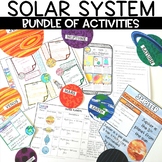Solar System Activities Inner and Outer Planets
- Zip
- Google Apps™

What educators are saying
Also included in
- Teach your students about the planets, asteroids, comets, and meteors of our solar system with this bundle of science worksheets, graphic organizers, a project, and a digital game. Students will demonstrate their learning of terrestrial and gas giant planets through comprehension questions, graphicPrice $6.30Original Price $9.00Save $2.70
Description
Teach your students about the inner and outer planets, comets, asteroids, and meteors of the solar system through reading worksheets, comprehension questions, and graphic organizers. Students will learn about the characteristics of terrestrial and gas giants, where the planets Mercury, Venus, Earth, Mars, Jupiter, Saturn, Uranus, and Neptune are located in the solar system, as well as other space objects such as asteroids, comets, and meteors.
Like this lesson? Check out the solar system unit and save 20% by clicking here.
Students will learn:
- What characteristics do the inner planets have in common?
- What are the main characteristics that distinguish Mercury, Venus, Earth, and Mars?
- What characteristics do the gas giants have in common?
- What characteristics distinguish Jupiter, Saturn, Uranus, and Neptune?
- What are the characteristics of comets?
- Where are most asteroids found?
- What are meteoroids and how do they form?
This solar system lesson includes:
- Sneak Peek into My Classroom: Learn tips on how I use the DIGITAL AND PRINTABLE lessons in my classroom (YES! You can use the digital lessons in your secure learning management systems such as Schoology, Google Classroom, Seesaw, etc.)
- Science texts for
- Terrestrial planets
- Gas giants
- Comets, asteroids, meteors
- Digital links to the Google Slides readings on the inner and outer planets
- Sketch note graphic organizers for
- Inner planets
- Outer planets
- Solar system
- Digital links to the Google Forms assessments for the terrestrial and gas giant assessments
- Answer key
How to use this planets activity in your classroom:
- Science centers
- Sub plans
- Independent learning activity
- Divide the class into 2 groups; inner and outer planets. Students read to learn and share out information on chart paper
- Whole class activity
- Sum it up: Using graphic organizers
Teacher feedback:
- I am so excited to utilize this resource to supplement what we are learning in our PLTW Planets of the Universe Science unit midway through the year! There are some awesome activities that will most definitely help reinforce what they are learning in the PLTW unit. Thanks so much! :)
- Teaching Muse's science resources are always engaging and power packed. My students learn so much when I use these units!
- I used this with my 4th graders. It was easy to use and my kids loved learning the basics about each planet and can now identify inner from outer. It was a great hands on (coloring) way to get them engaged. Would definitely use it again!
- This resource has everything-- reading passages, questions, fill in the blank, tables, and graphic organizers! The passages are easy to follow and gather information. The text is student-friendly. This was a great supplement to my Solar System unit!
Other lessons and activities to support your unit on the solar system:
- Solar System Bundle of Activities
- Planetgram Project
- Digital Planet Project
- Planets of the Solar System Digital BOOM Cards for Distance Learning
Kindly Note: If you have questions, do not hesitate in emailing me at Teaching Muse Email
PLEASE PREVIEW BEFORE PURCHASING
____________________________________________________________________________________
Thank you for visiting Teaching Muse. I would love for you to become a follower.
Teaching Muse followers receive new product information and discounts on any new items!
____________________________________________________________________________________
All rights reserved by Teaching Muse. This product is to be used by the original downloader ONLY. Copying for more than one teacher, classroom, department, school, or school system is prohibited. Additionally, this product may not be distributed or displayed digitally for public view. Failure to comply is a copyright infringement and violates the Digital Millennium Copyright Act (DMCA). They are intended for classroom and personal use ONLY.






